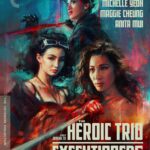Holiday: No Escape, by Scott Nye

“Wide shot, long take” has been the default aesthetic for international art house cinema for so long now that its employment – once radical – is now routine. The ease with which a series of auteurs have worn the vitality that Akerman, Antonioni, Tarr, and a whole slew of Romanians brought to the form is encouraging in its good taste, but tends to reveal pretty quickly when the aesthetic masks a dearth of inspiration.
Isabella Eklöf – best known for cowriting the similarly turgid Border last year – makes her directorial debut with Holiday, which finds a group of Danish gangsters on vacation, told from the point of view of their leader’s much-younger girlfriend Sascha (Victoria Carmen Sonne). They have a nice house, a big pool, they’re brash and arrogant and tend to claim any space as their own. Sascha is young, lonely, and fits in well with the lavish, low-key lifestyle the mobsters are temporarily affecting. But you try taking a man as devoted to his work as Michael (Lai Yde) away from it entirely. Violence, or the potential for violence, creeps in almost from the jump; even the way he caresses Sascha in bed carries with it an air of dominance. And when she meets a friendly young Dutch man at an ice cream shop, well…mob bosses tend not to be known for their lack of jealousy.
Things grow gradually more upsetting, culminating an an extremely graphic rape scene that is as pointedly confrontational as its most obvious forebearer, Irreversible, if only for how blatantly it steals that scene’s complicating incident. What makes Holiday’s use of the lingering figure more upsetting is their closeness – unlike Irreversible, the figure is not a random stranger who happened to come by, but another houseguest, and most likely the person to whom Sascha is closest. This is a group accustomed to looking the other way, or turning up the TV volume when a man is beaten in the adjacent room.
That I have to quality the woman in the background as “most likely” Sascha’s closest friend reveals the film’s central problem, which it attempts to capitalize into a strength – we really don’t know or understand Sascha beyond her circumstance, but she’s not so compelling a figure as to elicit our curiosity. She mostly just seems young and scared and way out of her depth, eager to take what she can from this arrangement, able to endure a certain level of abuse that comes with it. A telling scene early in the film introduces Sascha with a sudden black eye, perusing a jewelry store, having been told she can pick out anything she likes.
To what extent is Sascha complicit in this lifestyle, this business, these people? Is she purely a victim? Is she being influenced by them in ways to subtle for her to identify. By the time she really starts taking action on her own behalf, we’re only left to wonder, and the only move Eklöf has left is a glance into the lens and a cut to black, the ultimate surrender into art-house-ambiguous oblivion.



























